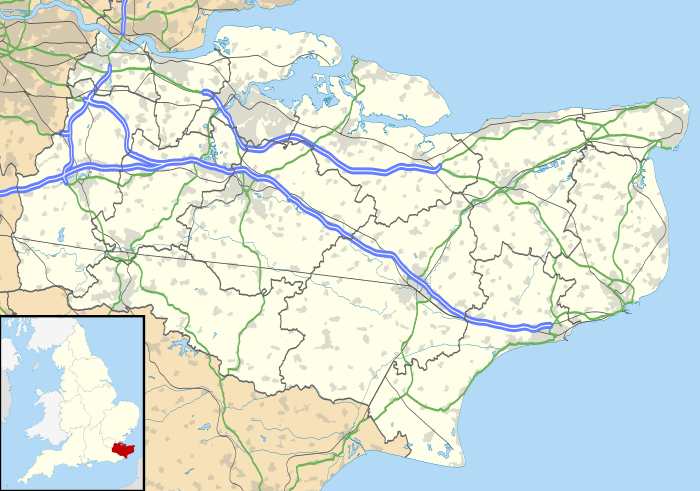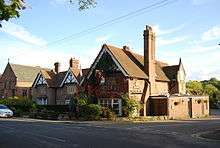Leigh, Kent
Leigh /ˈlaɪ/, historically spelled Lyghe, is a village and a civil parish located in the Sevenoaks district of Kent, England. It is located six miles (10 km) south of Sevenoaks town and three miles (5 km) west of Tonbridge.
| Leigh | |
|---|---|
 | |
 Leigh Location within Kent | |
| Area | 16.18 km2 (6.25 sq mi) |
| Population | 1,793 [1] |
| • Density | 111/km2 (290/sq mi) |
| OS grid reference | TQ555465 |
| District |
|
| Shire county | |
| Region | |
| Country | England |
| Sovereign state | United Kingdom |
| Post town | Tonbridge |
| Postcode district | TN11 |
| Dialling code | 01732 83 |
| Police | Kent |
| Fire | Kent |
| Ambulance | South East Coast |
| UK Parliament | |
There is a large village green; nearby is Hall Place, once Leigh Hall, occasionally open to the public, built in 1876. The parish church (13th century) is dedicated to St Mary.
History
The name of the village derives from the Old English leah, meaning a forest glade or clearing.[2]
Leigh is thought to have grown from a hamlet, evidence of which dates back to the late 11th century. Much of the land around the village was acquired in the 14th century by Sir John de Pulteney, owner of nearby Penshurst Place. In 1533, the estate passed to the Sidney family who retained ownership of most of this land until the early 20th century.[3]
The village grew substantially in the 19th century when the Baily and Morley families built many of the distinctive buildings present today, including Hall Place, East and Old Lodges, The Square, Forge Square and School Master's House. The Tonbridge to Redhill railway was built in 1842 to the south of the village, bringing further growth in population.[3]
Government
Leigh is administered by Sevenoaks District Council and Kent County Council. It falls within the UK parliamentary constituency of Tonbridge and Malling.
The parish of Leigh also includes the hamlet of Charcott as well as the areas of Powder Mills and Moorden.
Community facilities

The Fleur De Lis is the only public house in the village itself, although the Plough Inn is located to the east of the village on Powder Mill Lane. The Fleur De Lis was originally built as cottages by Thomas Baily in 1855, but was bought by a local brewery, Bartrum and Company, in 1870.[4]
Transport
Leigh railway station is on the Redhill to Tonbridge line and is located to the south of the village centre. It opened as "Leigh Halt" in 1911 but has been named "Leigh" since 1969.
The former Penshurst Airfield was located within the parish, to the south of Charcott. It operated mainly as a military airfield in 1916–1936 and 1940–1946. The remaining buildings were removed in 1991.
St Mary's Church
The present parish church was built in the 13th century, although a church is believed to have stood in a similar position for over a thousand years.[5] It occupies the highest point of the village, overlooking the village green.
The church was reconstructed in the 19th century by two architects, George Devey and Charles Baily, who had been employed by the Lay Rector (Lord de Lisle) and the Parish respectively, the two parties being responsible for different parts of the building. The two architects used different types of stone to reconstruct the building.[5]
Notable people
- Amy Catherine Walton (1849–1939), writer of noted Christian literature for children, moved to Leigh with her priest husband, Octavius Frank Walton, in 1906. He retired in 1918, but they soon moved back.
See also
- October 1926 Air Union Blériot 155 crash, which was within Leigh parish
References
- Census, 2011
- "Key to English Place Names". University of Nottingham - Institute for Name Studies. Archived from the original on 12 October 2016. Retrieved 3 September 2014.
- "A Brief History of Leigh". Leigh Parish Council website. Leigh Parish Council. Retrieved 3 September 2014.
- "Fleur De Lis". Leigh & District Historical Society. Retrieved 25 November 2014.
- "St Mary's Church". Leigh & District Historical Society. Retrieved 25 November 2014.
External links
| Wikimedia Commons has media related to Leigh, Kent. |
- Leigh Parish Council website
- Village notes Check for villages starting with L
- St Mary's church
- Leigh & District Historical Society
- Leigh during the Second World War
- Leigh barrier
